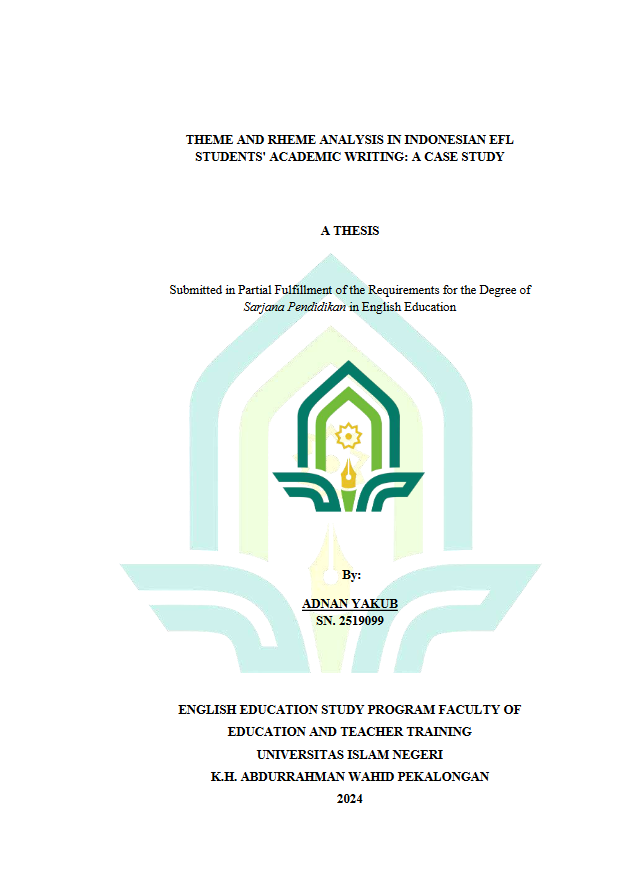
SKRIPSI TADRIS BAHASA INGGRIS
Theme And Rheme Analysis In Indonesian EFL Students' Academic Writing: A Case Study
This research investigated the use of theme and rheme in the academic writing of Indonesian EFL (English as a Foreign Language) students. The study was conducted with English Language Teaching Department students at one of the universities in Pekalongan, focused on how they apply theme and rheme structures to produce cohesive and coherent texts. This study used a qualitative approach based on Miles, Huberman, and Saldana (2014), data were collected from eight essay samples written by sixth-semester students. The analysis framework is rooted in Halliday and Matthiessen's (2014) theory of theme and rheme, which emphasizes the importance of these elements in structuring and organizing information within a text. The findings revealed a significant preference for unmarked topical themes, particularly nouns, which accounted for 183 out of 326 clauses. Textual themes were the second most used, while marked themes and interpersonal themes were less frequently employed. The study also found that the lack of interpersonal themes indicates a need for instruction on integrating the writer's perspective into their texts. Based on these findings, recommendations include emphasizing the importance of theme and rheme in writing instruction, encouraging the use of marked themes, and incorporating exercises on cohesive devices. Promoting the use of textual and interpersonal themes is also essential for achieving smooth transitions and clear relationships between ideas, thus enhancing the overall coherence and engagement of academic texts. This research addressed two primary questions: how theme and rheme were applied in students' academic writing and which themes were most dominantly used, providing insights into effective academic writing practices for EFL students.
Ketersediaan
| 24SK2425072.00 | SK TI 24.072 ADN t | My Library (Lantai 3, R. Local Content) | Tersedia |
Informasi Detail
- Judul Seri
-
-
- No. Panggil
-
SK TI 24.072 ADN t
- Penerbit
- Pekalongan : Program Studi Tadris Bahasa Inggris FTIK UIN K.H. Abdurrahman Wahid Pekalongan., 2024
- Deskripsi Fisik
-
xiv, 62 hlm., 24 cm; Bibliografi: 63-66
- Bahasa
-
Inggris
- ISBN/ISSN
-
-
- Klasifikasi
-
420.7
- Tipe Isi
-
-
- Tipe Media
-
-
- Tipe Pembawa
-
-
- Edisi
-
-
- Subjek
- Info Detail Spesifik
-
-
- Pernyataan Tanggungjawab
-
Adnan Yakub (2519099)
Versi lain/terkait
Tidak tersedia versi lain
Lampiran Berkas
Komentar
Anda harus login sebelum memberikan komentar
 Karya Umum
Karya Umum  Filsafat
Filsafat  Agama
Agama  Ilmu-ilmu Sosial
Ilmu-ilmu Sosial  Bahasa
Bahasa  Ilmu-ilmu Murni
Ilmu-ilmu Murni  Ilmu-ilmu Terapan
Ilmu-ilmu Terapan  Kesenian, Hiburan, dan Olahraga
Kesenian, Hiburan, dan Olahraga  Kesusastraan
Kesusastraan  Geografi dan Sejarah
Geografi dan Sejarah